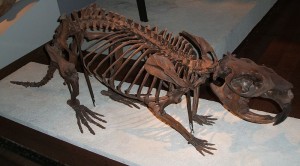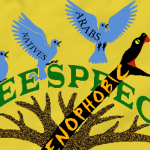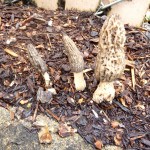In my last post, I introduced the model of the triune brain (reptilian, old mammalian, new mammalian) as a structure for basic understanding of yourself as a human animal, not just a human being. If you have not yet read the first part of this series, please go and check it out over here before reading on, as it will help you make sense of this second portion, for it is here is where we can put the theory into practice.

Before you begin, there is one thing to consider—do you want to specifically work with the totems of species that are considered most likely to be our direct ancestors, or of species that simply share the same general brain structures we have? For example, let’s say you want to learn more about the old mammalian brain by working with the totem of an animal whose most advanced neurological development is at that level. Would you prefer to specifically seek out Thrinaxodon, a cynodont closely related to the as-of-yet-undiscovered exact predecessor species of all mammals, humans included? Or would you rather work with the totem of an extant species of primitive mammal which is not a direct ancestor of ours, such as American Opossum?
Either way, prepare to do some preliminary research. There’s plenty of information on animals still alive today, but not quite as much on extinct ones, especially older or less charismatic species. Here is a good starting point for researching our likely direct ancestors; as with anything on Wikipedia take it with a bit of salt, but also make use of the cited resources for further research.
It may seem a little like “cheating” to go into a guided meditation with certain species more at the forefront than others, but considering how difficult traversing your own psyche can be, working with animals you know more about can help give you more of an anchor as you dig in deeper. Let the meditation choose the specific animals for you, though. Go in with a good amount of information in your conscious mind, and allow your subconscious to make use of the material.

The Meditation
Get comfortable in a quiet place where you can be undisturbed for at least an hour. Sit or lay down as you see fit. You can even dance if it will help you travel into the right mindset. Let go of your everyday cares and concerns, and relax.
Focus on your head. Feel your attention going inward, into your head, through your skull, and into your brain. The first place you enter into is the new mammalian brain.
Remember your social skills, the basic interactions between humans. Think of how we socially interact, the structure and processes of how we choose who to communicate with, who is close to us and who isn’t, how we collaborate and come together. Then think of how other higher-order mammals do the same. What makes us unique? How are we like other mammals in that respect?
Envision an animal coming toward you that represents the new mammalian brain and its origins. Let it approach you. Greet it, and see if you can engage it in conversation. Find out why it has arrived in this part of your brain. Once you’re done with this conversation, thank the totem for introducing itself, and bid it farewell.
Next, move deeper into your brain. Feel yourself move through the new mammalian brain, and into the old mammalian brain. Remember all the times you’ve felt deep, seemingly uncontrollable emotions, good or bad. Feel the bonds between you and those closest to you; don’t think about them, just feel them. Then think about mammals caring for their young, cleaning them and keeping them safe. Think about how other animals show care for each other—sadness when a fellow creature dies, joy at reunion with one who has been away.
Envision an animal coming toward you that represents the old mammalian brain and its origins. Let it approach you. Greet it, and see if you can engage it in conversation. Find out why it has arrived in this part of your brain. Once you’re done with this conversation, thank the totem for introducing itself, and bid it farewell.
Now, move to the deepest part of your brain, down at the base of the skull. This is the oldest part of all. Think of any situations, perhaps an emergency if you’re comfortable, where you simply acted without thinking. Remember the basic impulses of survival—sating hunger, finding rest, acquiring resources. Think of all the animals do to survive; think of fish, and amphibians, and reptiles, and others, all working to live each day.
Envision an animal coming toward you that represents the reptilian brain and its origins. Let it approach you. Greet it, and see if you can engage it in conversation. Find out why it has arrived in this part of your brain. Once you’re done with this conversation, thank the totem for introducing itself, and bid it farewell.
Then envision yourself traveling down your spine, and let your awareness expand throughout your entire body. Feel yourself back in your entire self, and when you are ready, open your eyes and come back to full waking awareness. Ground yourself as needed.

As mentioned before, this meditation is just the start. In the third and final section, I’ll give you some ideas on where to go from here, now that you’ve been introduced to these totems.











